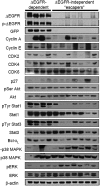Mutant EGFR is required for maintenance of glioma growth in vivo, and its ablation leads to escape from receptor dependence
- PMID: 20133782
- PMCID: PMC2823874
- DOI: 10.1073/pnas.0914356107
Mutant EGFR is required for maintenance of glioma growth in vivo, and its ablation leads to escape from receptor dependence
Abstract
Epidermal growth factor receptor (EGFR) gene amplification is the most common genetic alteration in high-grade glioma, and approximately 50% of EGFR-amplified tumors also harbor a constitutively active mutant form of the receptor, DeltaEGFR. Although DeltaEGFR greatly enhances tumor growth and is thus an attractive target for anti-glioma therapies, recent clinical experiences with EGFR kinase inhibitors have been disappointing, because resistance is common and tumors eventually recur. Interestingly, it has not been established whether DeltaEGFR is required for maintenance of glioma growth in vivo, and, by extension, if it truly represents a rational therapeutic target. Here, we demonstrate that in vivo silencing of regulatable DeltaEGFR with doxycycline attenuates glioma growth and, therefore, that it is crucial for maintenance of enhanced tumorigenicity. Similar to the clinical experience, tumors eventually regained aggressive growth after a period of stasis, but interestingly, without re-expression of DeltaEGFR. To determine how tumors acquired this ability, we found that a unique gene, KLHDC8, herein referred to as SDeltaE (Substitute for DeltaEGFR Expression)-1, is highly expressed in these tumors, which have escaped dependence on DeltaEGFR. SDeltaE-1 is also expressed in human gliomas and knockdown of its expression in DeltaEGFR-independent "escaper" tumors suppressed tumor growth. Taken together, we conclude that DeltaEGFR is required for both glioma establishment and maintenance, and that gliomas undergo selective pressure in vivo to employ alternative compensatory pathways to maintain aggressiveness in the event of EGFR silencing. Such alternative pathways function as substitutes for DeltaEGFR signaling and should therefore be considered as potential targets for additional therapy.
Conflict of interest statement
The authors declare no conflict of interest.
Figures





References
-
- Libermann TA, et al. Amplification, enhanced expression and possible rearrangement of EGF receptor gene in primary human brain tumours of glial origin. Nature. 1985;313:144–147. - PubMed
-
- Ekstrand AJ, et al. Genes for epidermal growth factor receptor, transforming growth factor alpha, and epidermal growth factor and their expression in human gliomas in vivo. Cancer Res. 1991;51:2164–2172. - PubMed
Publication types
MeSH terms
Substances
Grants and funding
LinkOut - more resources
Full Text Sources
Molecular Biology Databases
Research Materials
Miscellaneous

